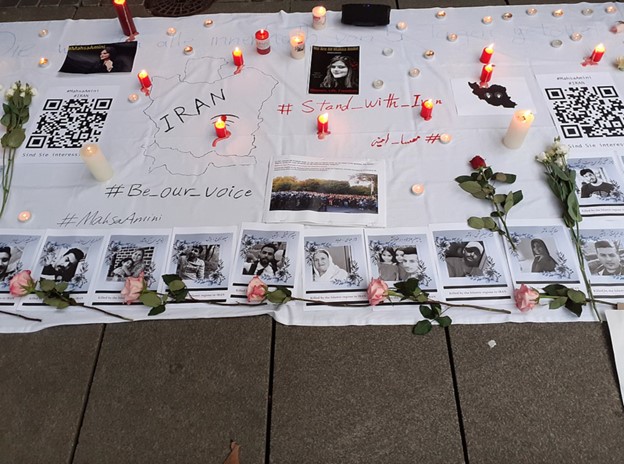Gathering
Invite students to have a look at the following image. What do they think it’s of? What might it be about?

Elicit and explain that this is an image taken at a Mahsa Amini protest in Stuttgart, Germany. The protest was one of many around the world in solidarity with the women of Iran in the fall of 2022.
Check Agenda
Explain that in today’s lesson, we’ll be exploring the demonstrations that spread across Iran (and beyond) since September 2022. We’ll look at what triggered them, what issues the demonstrators are trying to highlight and address, and how these issues relate to what is happening in other parts of the world, including the U.S.
Women, Life, Freedom!
Ask students if they’re familiar with the chant: “Women, Life, Freedom!”
Ask:
- What might the chant be in response to?
- Do you know its origins?
- How has it been popularized recently?
Elicit and explain that “Women, Life, Freedom!” is the rallying cry of protesters in a country-wide uprising against women’s oppression in Iran. Originally, it was the main slogan of the Kurdish feminist movement, but it has since become a symbol of feminist solidarity in Iran and beyond.
The protests in Iran were triggered by the killing of 22-year-old Zhina (Mahsa) Amini, at the hands of Iran’s “morality” police—a unit of Iran's police force, tasked with enforcing the country’s Islamic dress code in public. Mahsa Amini was arrested for allegedly not wearing her hijab (headscarf) correctly, i.e. some of her hair was showing. A few hours after her arrest, she was admitted to the hospital with severe head injuries sustained while in custody. She never woke up from her coma and died three days later, on September 16, 2022.
According to United States Institute of Peace fellow Robin Wright: “Protest chants about her death quickly evolved into calls to oust the regime …. They began chanting ‘Death to the Dictator,’ and ‘Our disgrace is our incompetent leader,’ and ‘We don’t want the Islamic Republic.’”
Iran’s security forces, such as the Basij militia, attacked protesters, fueling popular anger. As of October 11, those attacks had killed 185 protesters, including 19 children, according to the monitoring group Iran Human Rights.
The U.S. Institute of Peace reports that:
Iran’s women are seizing worldwide admiration with 26 [plus] days of courageous defiance against their authoritarian government’s violent confinement of females as second-class citizens who may not freely work, marry, divorce, travel or even be seen with their heads uncovered….
Iran’s widened protests this week, including workers’ strikes and Iran’s vital oil sector, underscore that its women are now leading the most potent challenge in years to the authoritarian rule by clerics and their allied security forces..
Women and their allies have taken to the streets around the world to support the protests in Iran – including in Stuttgart, Germany, where the photo we saw earlier was taken. That photo is of a commemoration of Iranians killed in anti-Regime protests.
Images of protests in Iran are hard to come by because the regime is cracking down on communications and any news being broadcast about the protests, whether in Iran itself, or abroad. And yet, news of the protests continues to spread.
Spreading Protests across Iran
Invite students to watch the following BBC Tik Tok video about spreading protests in Iran and the difficulties in reporting on the protests.
NOTE: This 3-minute video includes footage of the violent crackdown on protesters in Iran.
Tik Tok @BBCnews: These are the protest videos Iran doesn’t want the world to see #mahsaamini #iranprotests #bbcnews
After viewing the video, ask students to discuss:
- What are your thoughts and feelings about the video?
- What does the video show?
- What does the video say about the Iranian Regime?
- How are people in Iran (including the BBC) getting around that?
- According to the video, how are these protests different from other protests?
- Do you think the reporting of these protests is important? If so, why?
- Why might the Iranian regime say that the protesters are a dangerous threat?
- Why might they charge the U.S. and Israel with being behind spreading unrest in Iran?
Control of Women’s Bodies
In another Tik Tok video, this one posted by AJPlus, Iranian American writer and activist Hoda Katebi talks about the protests spreading across Iran and shares her insights about some of the reasons why they are happening.
Play the following 3-minute video from AJPlus:
Tik Tok @AJPlus : Iran’s uprising is about more than hair and hijabs
#iran #mahsaamini #iraniantiktok #iranianprotests2
After watching the video, ask students:
- What does Hoda Katebi claim is the root of the issue?
- What does she say is the root of the anger?
- Even though women are cutting their hair and burning their hijabs (headscarves), Katebi claims the protests are not about the actual wearing of the hijab. What does she say that the protests are really about?
- How does this relate to women’s issues in Iran?
- How does this relate to women’s issues elsewhere in the world?
- How does this relate to women’s issues in the U.S.?
- How does this relate to how other marginalized groups are treated?
- What does Hoda Katebi say about American involvement in Iran? What has been the impact, according to Katebi, on the Iranian regime? What about the impact on ordinary Iranians?
- What does Katebi say about how governments express domination over women’s bodies?
- How does Katebi encourage us to look at what’s happening in Iran in a broader way?
Finally, ask students:
- What stands out for you in the images, videos, and readings we’ve shared about the death of Mahsa Amini and the reaction to it?
Closing
Invite students to reflect on the following statement by the writer Maya Angelou:
“Each time a woman stands up for herself, without knowing it possibly, without claiming it, she stands up for all women.”